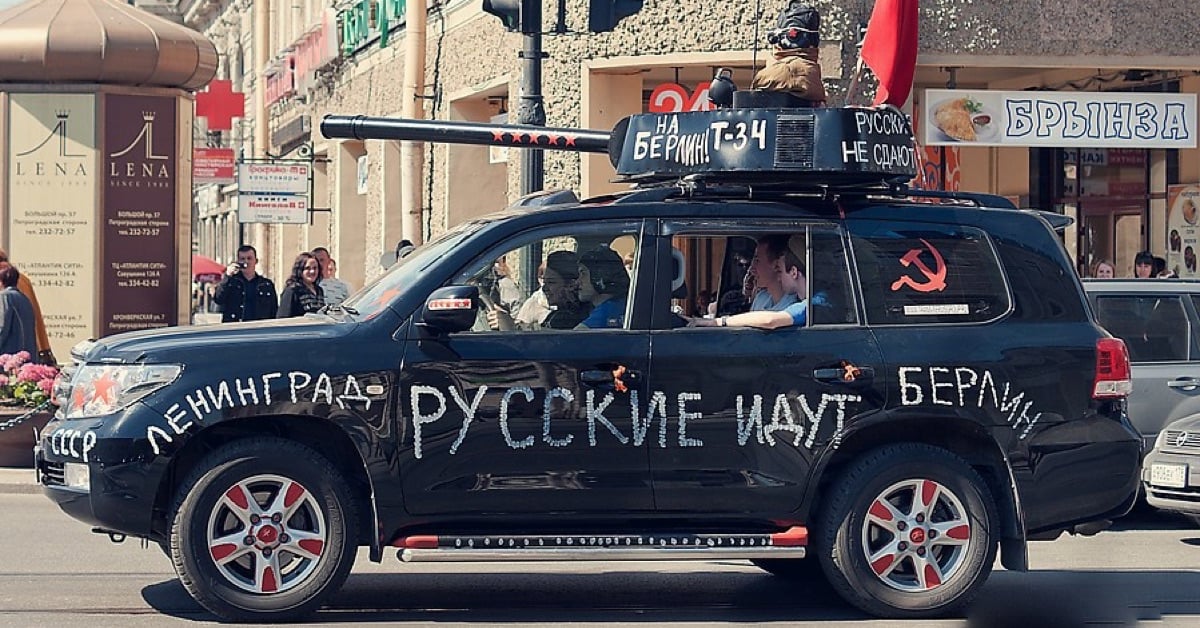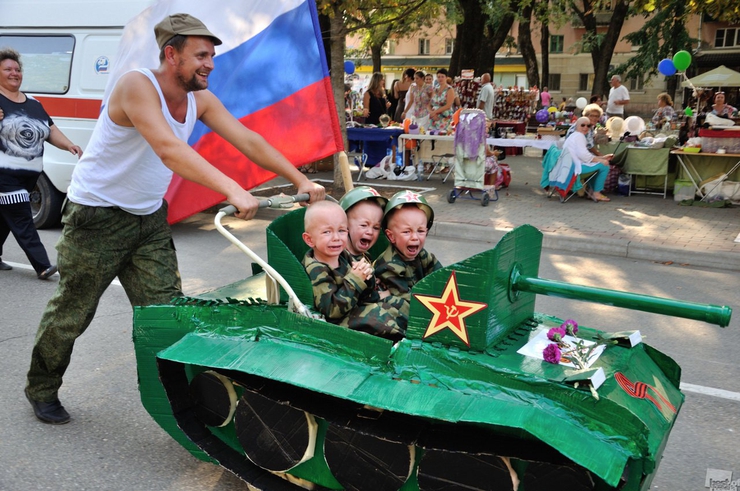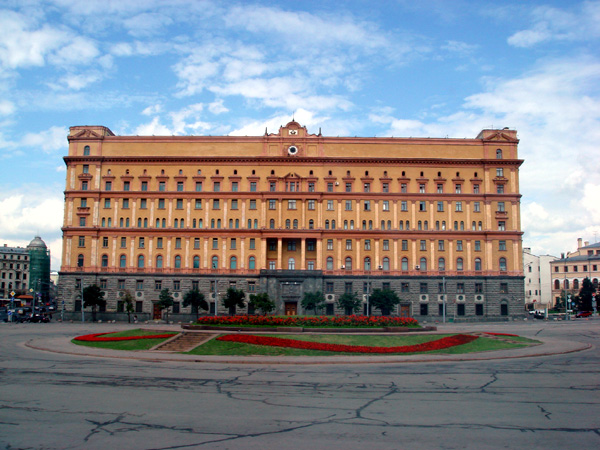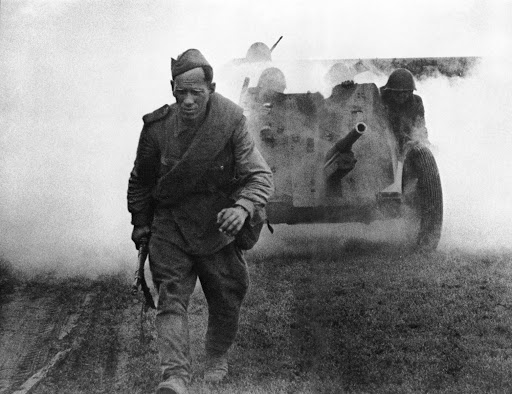In the Fog of Victory: Glorification of the Soviet legacy in Russia
Soviet Union, which included the area of modern Russia, lost approximately 27 million people in World War II according to various estimates. Russia expert Vladimir Jushkin explains how the commemoration of victims of war has gradually become a state-organised militarist pursuit that overshadows Soviet regime’s crimes, ineptitude and war-time human suffering. Such national efforts have lately increasingly focused on the distortion of facts concerning the beginning of the war and on justifying Soviet Union leadership’s criminal activities.
Immediately after the war, Victory Day was officially commemorated only three times, from 1945 to 1947, after which it reverted to being an ordinary workday. Brezhnev, who came to power in 1964, placed his stakes on a mobilising myth not of the future, but rather from the past. The cult of perished heroes who paved the way to victory at the price of their lives started spreading every more broadly. The first official celebrations were organised in 1965 for the 20th anniversary of victory. Thereafter a military parade was held in honour of victory in the jubilee years of 1975, 1985 and 1990.

The federal law ‘On the Remembrance of the Victory Achieved by the Soviet People in the Great Patriotic War’ was adopted in 1995, after which a victory parade started being held every year. Military equipment has been included in the parade since 2008. According to sources connected to the army, the idea of ‘making noise’ originated from the president’s administration (this is a tiresome additional duty for military personnel themselves).
But why did Stalin stop commemorating Victory Day in 1947? Perhaps he did not consider the victory to be his own exclusive red-letter day. In 1945, Stalin stood a little bit to the side on the mausoleum’s platform, allowing the front-line generals to stand in the middle, and Zhukov gave the parade speech.
Two versions are prevalent. First, it is possible that Stalin dreaded the victorious people (memory of the war was not so much victorious and joyful as appalling and horrible: hundreds of thousands of cripples with amputated limbs were left adrift by the state and moved about throughout the land, women in villages cried their eyes out in mourning for their lost husbands and sons). On the other hand, it is possible that Stalin felt guilty before the Russian people for millions of victims.
At a reception held at the Kremlin on 24 May 1945 in honour of the participants in the victory parade, Stalin said as he raised his glass in honour of the Russian people and speaking about the mistakes made in 1941–1942: ‘Some other people could have said to its government: you haven’t lived up to our expectations, step aside, we’re putting a new government in office.’ At that time, it was apparently felt in the Kremlin that festively celebrating victory achieved at the price of so many millions of victims was sacrilege (it is more a day of mourning).
Nowadays, when the front-line soldiers and veterans who had experienced the war and not only just heard about it are no longer among us, the meaning of the mythology of the great victory has only grown year after year.
Day of Lust for Revenge
Victory Day was always secondary in the Soviet Union, far behind 1 May and 7 November with their mighty demonstrations and parades. The symbols of the great victory were left in the shadows of the main ideological symbols of socialism and revolution. The glorious emergence of the current Victory Day is tied to the fact that all the symbols of the Soviet era – the cosmos, the progressive system of government, faith in the future – have faded away. Victory is left as the only moral basis for self-justification and self-respect. Several ulterior motives can be seen in the evolution of Victory Day.

First of all, Victory Day has become an occasion for recalling the military triumph of the Stalinist Soviet Union and for anchoring the powerful status of today’s Russia, the successor of the Soviet victor state. The role of the state in the history of the war and the victory is demonstratively emphasised. Taken to its logical conclusion, this is expressed in the phrase, ‘Stalin won the war’.
Secondly, the content of celebrating this holiday has changed – an element of topicality has been added to it. The concept of the ‘fascist’ is also filled with new meaning. It now includes the opposition that is outside the system, the leaders of those countries that do not consent to attend the victory parade, as well as the Ukrainian authorities. ‘Holy war’ carries over from the past into the present and has become a key point in Vladimir Putin’s global agenda. The conservative writer Aleksandr Dugin has straightforwardly declared this new understanding: ‘After Ossetia, Abkhazia, the Crimea, the Donbass region and Syria, we Russians have returned to history again. Our new victories – completely real and likewise quite difficult – make our Great Victory fresh, incisive and sharp again.’ In this light, the slogan ‘1941-1945. We can repeat it’, which is widespread among the people, becomes understandable.
Thirdly, Victory Day has become one of those historical-psychological events that belong to the fixed assets of Russian society’s ‘spiritual foundations’, making it possible to shape a new post-Soviet identity. In present day Russia, 9 May is a mainstay of national identity, the basis of collective pride and self-respect, the regime’s moral capital.

Fourthly, it is not so much the defeat of Hitler that is commemorated anymore with the parade at Red Square, rather, Putin’s policy of using military force to radiate Russia’s might beyond the state’s borders is brutally glorified. In 2015, 9 May was a dual Victory Day: the overall victory day of all Russians, and Putin’s personal victory day. For the first time at the parade, Russia’s President declared a minute of silence. In the evening of that same day in prime time, the Rossiya television channel repeated the documentary film The Crimea – the Way to the Homeland, the basis of which is a lengthy conversation with Putin.
Fifthly, Putin placed an equals sign between ‘the Soviet Union and Russia with its thousand-year history’ in the speech that he gave before the parade in 2019. To a certain extent, this left the impression of aspirations to regain the territories of those 14 republics that in its day were part of the Soviet Union but now are independent countries. This is quite a serious declaration, especially on the occasion of a military parade.
The Anchoring of New Ideas in the Consciousness of the Elite and the Masses
The Cult of Victory
In 2015, on the 70th anniversary of the victory achieved over Nazi Germany, Patriarch Kirill called Easter Victory Day as well, thus completing the long process through which the role of the church in the war and in achieving victory over the enemy was reinterpreted. 9 May is a continuation of Easter. It is like a secular Easter, by which a certain kind of resurrection is similarly celebrated, only without the crucifixion because people celebrate victory without war. To put it another way, the Great Patriotic War and the victory of 1945 have become Russia’s popular religion
Regarding the possibility of aligning the cult of victory with the orthodox faith in sincere conviction, only a handful of dissidents in the Orthodox Church still oppose that nowadays, for instance Sergei Chapnin, who called that cult ‘pagan’ in 2011.
The Cult in Practice
There were rather few popular religious rites beyond the military parade until the mid-2000s, but new rites of that type have now been added with each passing year. The Ribbon of St. George events and Immortal Regiment events that have been held since 2005 and 2012 respectively are widely known, as are the strictly formalised ‘named’ events that resemble them, such as the ‘Hero Tree’, the ‘Victory Letter’, ‘Give a Veteran a Lift’, ‘Memorial Candle’, ‘Heroes of the Fatherland Day’, ‘Unknown Soldier Day’, etc. This category also includes victory posters put up spontaneously at the sides of streets and roads, the creation and dissemination of congratulations, slogans and pictures on social media, temporary personal abstinence from consuming or using products from abroad, driving vehicles decorated with phrases like ‘Going after German girls’ or ‘I’m taking a German to be executed’, as well as the organisation of patriotic adventure games for young people and of other events at school.
In other words, participating in the cult’s rites is an indication of people’s actual identity in society.
New Symbols
In terms of its symbolic meaning and practical usage, wearing the Ribbon of St. George resembles wearing a cross around one’s neck for Christians or wearing a yarmulke for Jews. In the first place, it points to identity as a ‘true patriot of Russia’, and on the other hand, in this way it gives its wearer the chance to feel good and comfortable in society, and to participate in rites. For this reason, it is important for people to wear the ribbon (or altogether ribbons) in a clearly visible place and thereby to ‘consecrate’ sundry objects such as vanity bags, knapsacks, baby carriages or automobiles.
The Usurped Immortal Regiment
Journalists in Tomsk (the television channel TV2 in Tomsk) organised the Immortal Regiment event in 2012. Back then it was not yet a state-sponsored event. Only those people who wanted to participated in it. The Kremlin took it over in 2014 ahead of the 70th anniversary of the victory, turned it into a mass event and equated participating in it with supporting the authorities: if you march in the Immortal Regiment, you support the authorities.
In any case, Russian remembrance customs do not in any way, not even in atheistic form, envisage the remembrance of the dead by portraits attached to the ends of poles (the dead are remembered at cemeteries). Needless to say, since this event is imposed from above, it will disappear when the ruling regime is replaced.

Fireworks Displays Celebrating Liberation
In 2019, Russia’s federal channels announced the schedule for so-called liberation fireworks displays from April of 2019 to May of 2020 to celebrate the liberation of 120 million people by the Soviet Army in the territory of 16 independent countries (including countries that are currently independent). In this way, the fireworks displays affirm imperial memory in a fashion and express the hope that one day the pieces of the former empire will come back to their home harbour.
Strategy for Mythologizing History
The firm conviction prevails in the Kremlin that citizens have to see pure geopolitics in the Second World War: the story of how the Soviet Union overcame its insidious enemy in the West.
12 Volumes of the Great Patriotic War
In 2015, the Russian Ministry of Defence brought to completion the publication of the 12-volume encyclopaedic collected work The Great Patriotic War 1941–1945. Nearly fifty members of the chief editing committee, a large expert group, 12 editing committees and 12 collectives of authors (corresponding to the number of volumes) laboured at compiling those volumes. All of those collectives in turn had dozens of assistants for doing the necessary scholarly organisational and verificatory work. As the result of what at first glance appears to have been a titanic effort, a cursory overview was completed of events and facts that have long since been known. The reader will not find anything new in those 12 volumes.
Archives of the Great Patriotic War
On 18 January of this year, when meeting with representatives of veterans and the patriotic public, Vladimir Putin spoke of establishing a ‘centre of archival documents, cinematic and photographic materials’ ‘to silence those who try to distort history…’ Which archival materials did Putin have in mind?
According to Mark Solonin, the most interesting parts of the army archives are closed off. The most important materials in particular have not been made available to the public: strategic plans, direct communications with the front lines, and various summaries. By the 75th anniversary of the victory, Ministry of Defence documents from the years 1939–1943 remain entirely closed off to public access. Documents of the Politburo and the State Defence Committee, and the personal archives of Stalin, Molotov, Khrushchev and Brezhnev are absolutely inaccessible. Then what is public? For instance, Ribbentrop’s name is not mentioned in any form in the ‘special file’ on August of 1939.
Yet that file does contain a protocol from 19 August, according to which the Politburo solved two exceedingly important problems: it named a new technical school after Nadezhda Krupskaya, and it extended the deadline for calling up workers who were digging a canal in Central Asia to perform their compulsory military service. This took place only four days before Ribbentrop’s arrival and 12 days before the start of the world war. A Politburo decision is found in the ‘files’ on June of 1940 that increased the rations of tobacco, matches and cigarette paper that were to be allotted in Red Army units that were carrying out ‘special missions’ (evidently this referred to the forces that were occupying the three Baltic states).

Remembrance of Victims of the Holocaust
The 2020 International Forum for Remembering Victims of the Holocaust turned out to be one more bridgehead from which Putin wages war against Western civilisation. He is trying to hitch up the state of Israel and the entire Jewish diaspora to the wagon for hijacking the victory achieved in the Second World War. To accuse the entire Western world of starting the war. To put the blame for the Holocaust on the shoulders of Europe and the USA. To depict itself as the most important preserver of its memory and the primary saviour and protector of the Jewish people, as the primary combatant against antisemitism, declaring everyone who is in opposition to be a fascist and a sympathiser of Hitler.
In Place of a Conclusion
In 1987, the front-line soldier and writer Viktor Astafyev wrote: ‘Soviet militarists are the most savage, the most cowardly, the most ignoble, the stupidest of all militarists who have ever lived on Earth. It is they who ‘won’ with the score 1:10! It is they who cast our people into the flames of war just like bundles of straw. [...] How many people did we ultimately lose in the war? [...] It’s awful to utter the true number, isn’t it? And when it is uttered, penitent’s garments should be put on instead of parade uniforms, they should fall to their knees on Victory Day before Russia and beg their people for forgiveness for the ineptly ‘won’ war, in which the enemies were thrashed with corpses, in which the enemies were drowned in the blood of Russians.’
